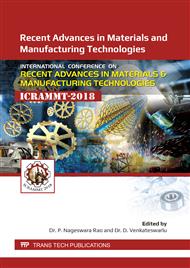[1]
Yan Cherng Lin, Biing Hwa Yan*, Yong Song Chang, Machining characteristics of titanium alloy (Ti6Al4V) using a combination process of EDM with USM, Journal of Materials Processing Technology 104 ,171±17 (2000).
DOI: 10.1016/s0924-0136(00)00539-2
Google Scholar
[2]
Lin Gu, LeiLi, Wansheng Zhao, K.P. Rajurkar, Electrical discharge machining of Ti6Al4V with a bundled electrode, International Journal of Machine Tools & Manufacture 53, 100–106, (2012).
DOI: 10.1016/j.ijmachtools.2011.10.002
Google Scholar
[3]
J.S. Soni, G. Chakraverti, Machining characteristics of titanium with rotary electro-discharge Machining, Wear, 171, 51-58 (1994).
DOI: 10.1016/0043-1648(94)90347-6
Google Scholar
[4]
M.Ghoreishi, J.Atkinson, A comparative experimental study of machining characteristics in vibratory, rotary, vibro rotary electro discharge machining, Journal of Material Processing Technology, 120, 374-384, (2002).
DOI: 10.1016/s0924-0136(01)01160-8
Google Scholar
[5]
M.G. Xu, J.H. Zhang, Y. Li, Q.H. Zhang, S.F. Ren, Material removal mechanisms of cemented carbides machined by ultrasonic vibration assisted EDM in gas medium, journal of materials processing technology 209, 1742–1746, (2009).
DOI: 10.1016/j.jmatprotec.2008.04.031
Google Scholar
[6]
M. P. Samueli and P. K. Philip, powder metallurgy tool electrodes for electrical discharge machining, Int. J. Mach. Tools Manufact. Vol. 37, No. I 1, pp.1625-1633, (1997).
DOI: 10.1016/s0890-6955(97)00006-0
Google Scholar
[7]
Thangadurai. K.R and Asha .A, Parametric optimization of edm process of aluminium boron carbide composite using desirability function approach and genetic algorithm, Applied Mechanics and Materials Vols. 592-594,pp.684-688, (2014).
DOI: 10.4028/www.scientific.net/amm.592-594.684
Google Scholar
[8]
B. Mohan, A. Rajadurai, K.G. Satyanarayana, Electric discharge machining of Al–SiC metal matrix composites using rotary tube electrode, Journal of Materials Processing Technology 153–154, 978–985, (2004).
DOI: 10.1016/j.jmatprotec.2004.04.347
Google Scholar
[9]
Marashi H, Jafarlou DM, Sarahan AAD, Mardi N.A. Employing severe plastic deformation to the processing of electrical discharge machining electrodes, Precision Engineering http://dx.doi.org/10.1016/j.precisioneng.2016.05.012 , (2016).
DOI: 10.1016/j.precisioneng.2016.05.012
Google Scholar
[10]
S. Oliver Nesa Raj and Sethuramalingam Prabhu, Analysis of multi objective optimisation using TOPSIS method in EDM process with CNT infused copper electrode, Int. J. Machining and Machinability of Materials, Vol. 19, No. 1, (2017).
DOI: 10.1504/ijmmm.2017.10002091
Google Scholar
[11]
Saroj Kumar Padhi, S.S. Mahappatra and Harish Chandra Das, Performance of a Electroplated Plastic Electrical Discharge Machining Electrode Compared to a Copper Electrode, International Journal of Pure and Applied Mathematics Volume 114 No. 7, 459-469, (2017).
Google Scholar
[12]
Kaveh Edalati, Kazutaka Imamura, Takanobu Kiss and Zenji Horita, Equal-Channel Angular Pressing and High-Pressure Torsion of Pure Copper: Evolution of Electrical Conductivity and Hardness with Strain, Materials Transactions, Vol. 53, No. 1 ,p.123 to 127, (2012).
DOI: 10.2320/matertrans.md201109
Google Scholar
[13]
N. Lugo J.M. Cabrera, N. Llorca, C.J. Luis, R. Luri, J. León,I. Puertas, Grain Refinement Of Pure Copper By Ecap, Materials Science Forum Vols. 584-586 , Pp 393-398, (2008).
DOI: 10.4028/www.scientific.net/msf.584-586.393
Google Scholar
[14]
Valiev R, Estrin Y, Horita Z, Langdon T, Zehetbauer M, Zhu Y. Fundamentals of superior sproperties in bulk nanoSPD materials. Materials Research Letters. 2015:1-21.
DOI: 10.1080/21663831.2015.1060543
Google Scholar


